University Finance Report: Procter & Gamble Corporate Finance
VerifiedAdded on 2023/04/19
|16
|3730
|117
Report
AI Summary
This report provides a comprehensive financial analysis of Procter & Gamble (P&G), examining its performance and strategies within the context of multinational corporate finance. The analysis covers company overview, ratio analysis (liquidity, profitability, and leverage), and the impact of economic environments and market conditions, including the 2007-2008 global credit crisis. It delves into international financial markets, exploring P&G's global presence and the effects of the crisis on its financial operations. The report addresses international financial market operations, the impact of exchange rates, and risk mitigation strategies, including techniques to hedge foreign exchange exposure and diversification. Furthermore, it examines company strategies, ethical and legal considerations, and the impact of these factors on both internal and external stakeholders. The report concludes with a discussion of future risks and challenges, including financing decisions, and strategies for ethical and legal compliance and risk mitigation.

Running head: MULTINATIONAL CORPORATE FINANCE
Corporate Finance
Name of the Student:
Name of the University:
Author’s Note:
Corporate Finance
Name of the Student:
Name of the University:
Author’s Note:
Paraphrase This Document
Need a fresh take? Get an instant paraphrase of this document with our AI Paraphraser
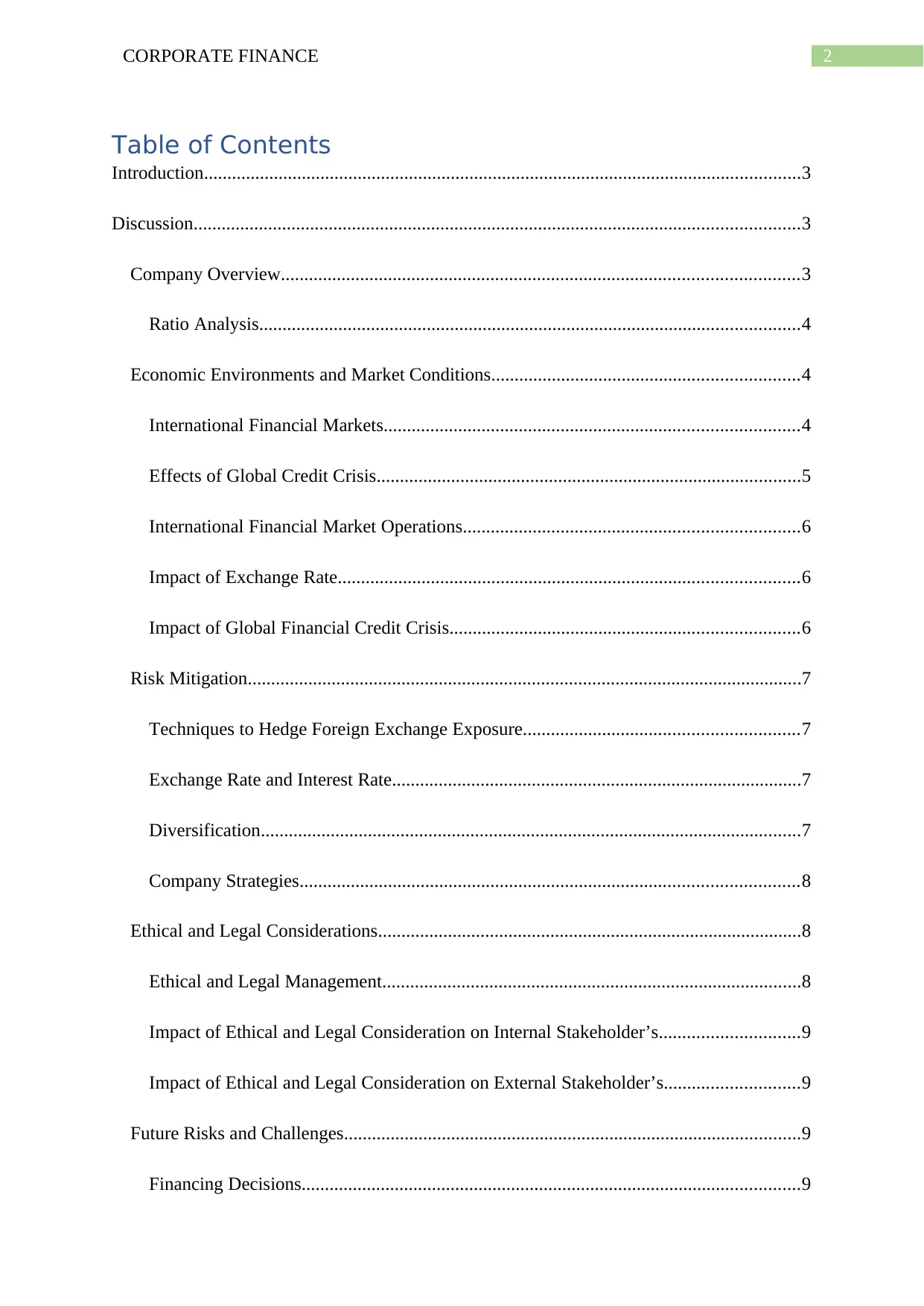
2CORPORATE FINANCE
Table of Contents
Introduction................................................................................................................................3
Discussion..................................................................................................................................3
Company Overview...............................................................................................................3
Ratio Analysis....................................................................................................................4
Economic Environments and Market Conditions..................................................................4
International Financial Markets.........................................................................................4
Effects of Global Credit Crisis...........................................................................................5
International Financial Market Operations........................................................................6
Impact of Exchange Rate...................................................................................................6
Impact of Global Financial Credit Crisis...........................................................................6
Risk Mitigation.......................................................................................................................7
Techniques to Hedge Foreign Exchange Exposure...........................................................7
Exchange Rate and Interest Rate........................................................................................7
Diversification....................................................................................................................7
Company Strategies...........................................................................................................8
Ethical and Legal Considerations...........................................................................................8
Ethical and Legal Management..........................................................................................8
Impact of Ethical and Legal Consideration on Internal Stakeholder’s..............................9
Impact of Ethical and Legal Consideration on External Stakeholder’s.............................9
Future Risks and Challenges..................................................................................................9
Financing Decisions...........................................................................................................9
Table of Contents
Introduction................................................................................................................................3
Discussion..................................................................................................................................3
Company Overview...............................................................................................................3
Ratio Analysis....................................................................................................................4
Economic Environments and Market Conditions..................................................................4
International Financial Markets.........................................................................................4
Effects of Global Credit Crisis...........................................................................................5
International Financial Market Operations........................................................................6
Impact of Exchange Rate...................................................................................................6
Impact of Global Financial Credit Crisis...........................................................................6
Risk Mitigation.......................................................................................................................7
Techniques to Hedge Foreign Exchange Exposure...........................................................7
Exchange Rate and Interest Rate........................................................................................7
Diversification....................................................................................................................7
Company Strategies...........................................................................................................8
Ethical and Legal Considerations...........................................................................................8
Ethical and Legal Management..........................................................................................8
Impact of Ethical and Legal Consideration on Internal Stakeholder’s..............................9
Impact of Ethical and Legal Consideration on External Stakeholder’s.............................9
Future Risks and Challenges..................................................................................................9
Financing Decisions...........................................................................................................9
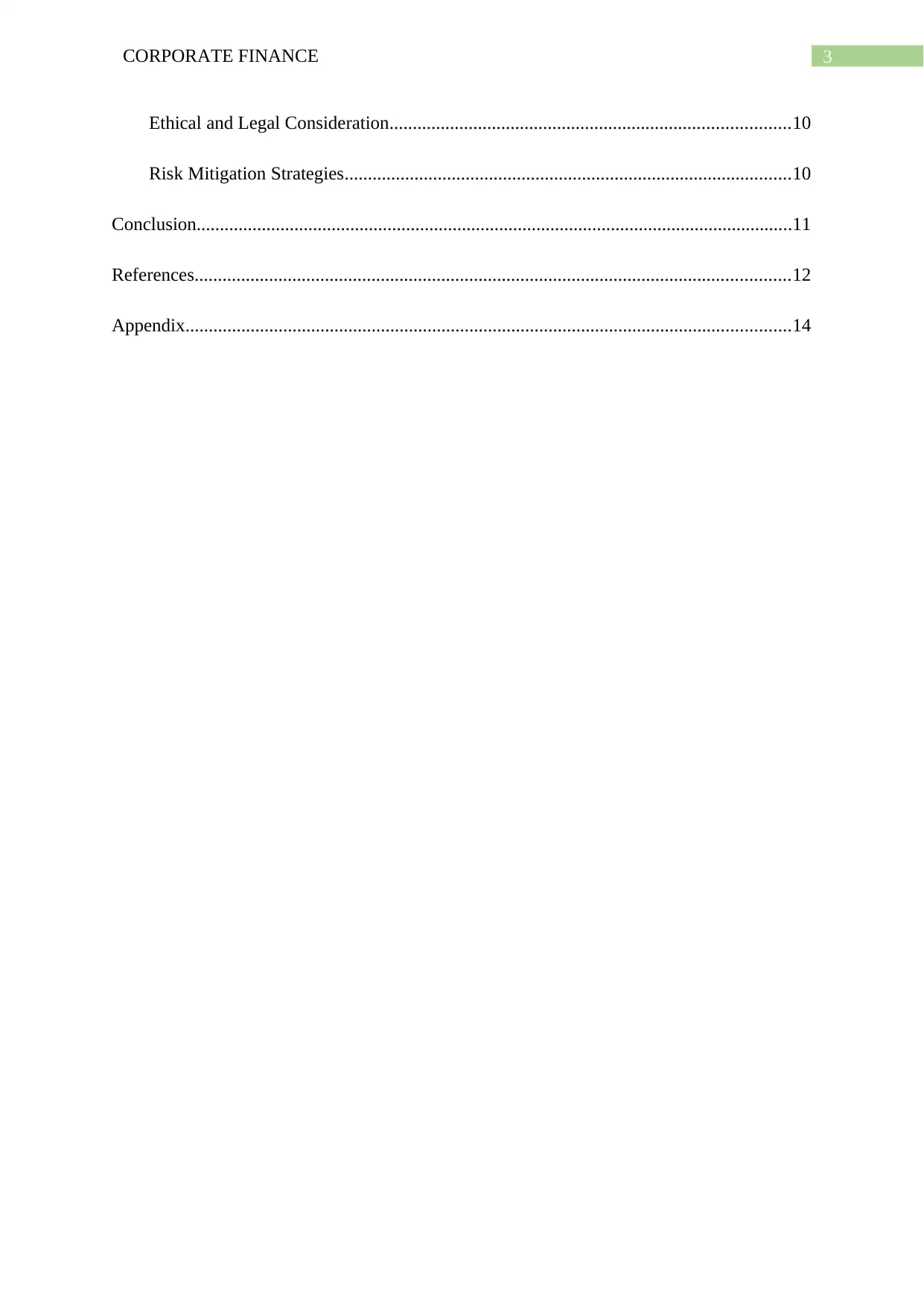
3CORPORATE FINANCE
Ethical and Legal Consideration......................................................................................10
Risk Mitigation Strategies................................................................................................10
Conclusion................................................................................................................................11
References................................................................................................................................12
Appendix..................................................................................................................................14
Ethical and Legal Consideration......................................................................................10
Risk Mitigation Strategies................................................................................................10
Conclusion................................................................................................................................11
References................................................................................................................................12
Appendix..................................................................................................................................14
⊘ This is a preview!⊘
Do you want full access?
Subscribe today to unlock all pages.

Trusted by 1+ million students worldwide
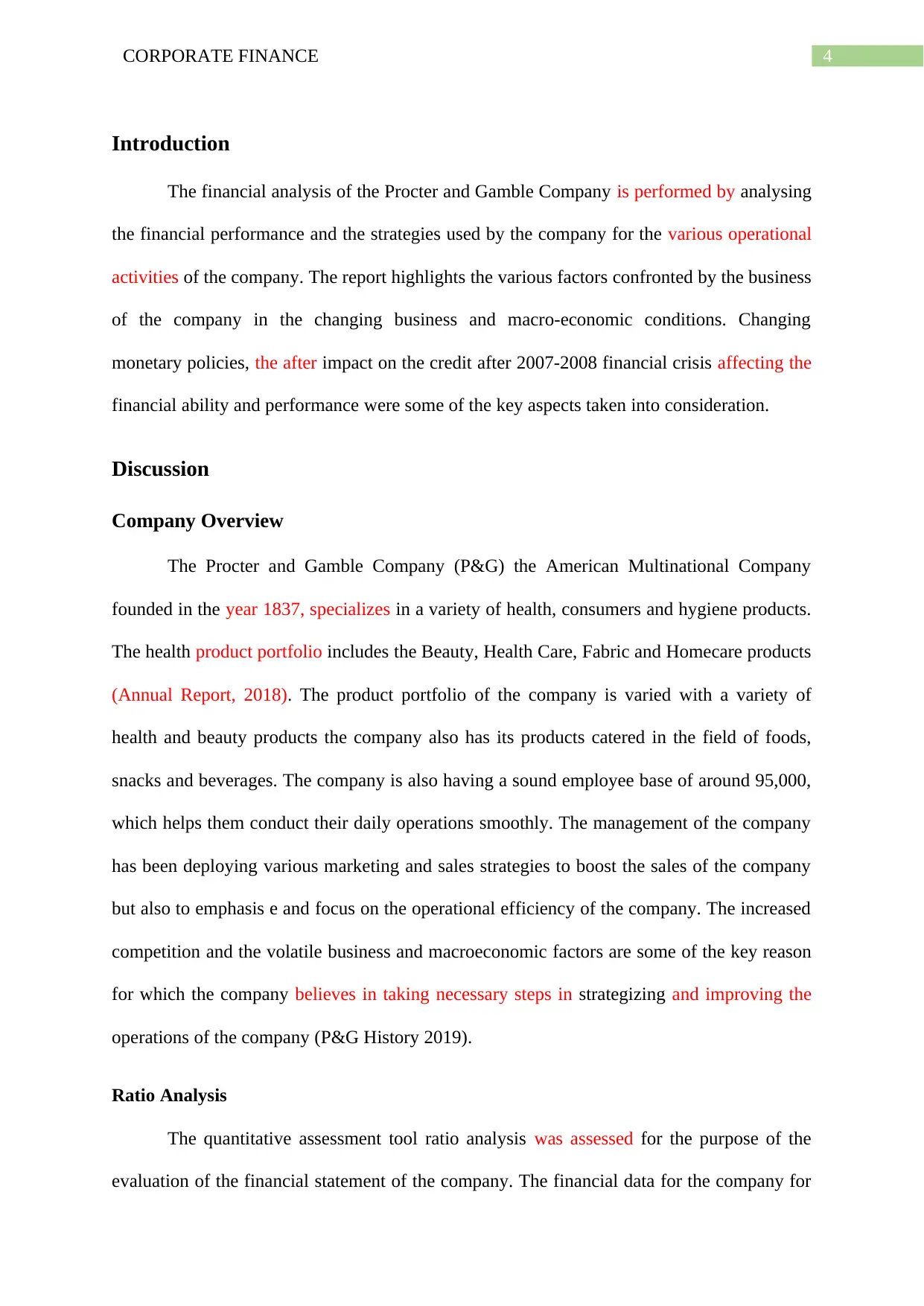
4CORPORATE FINANCE
Introduction
The financial analysis of the Procter and Gamble Company is performed by analysing
the financial performance and the strategies used by the company for the various operational
activities of the company. The report highlights the various factors confronted by the business
of the company in the changing business and macro-economic conditions. Changing
monetary policies, the after impact on the credit after 2007-2008 financial crisis affecting the
financial ability and performance were some of the key aspects taken into consideration.
Discussion
Company Overview
The Procter and Gamble Company (P&G) the American Multinational Company
founded in the year 1837, specializes in a variety of health, consumers and hygiene products.
The health product portfolio includes the Beauty, Health Care, Fabric and Homecare products
(Annual Report, 2018). The product portfolio of the company is varied with a variety of
health and beauty products the company also has its products catered in the field of foods,
snacks and beverages. The company is also having a sound employee base of around 95,000,
which helps them conduct their daily operations smoothly. The management of the company
has been deploying various marketing and sales strategies to boost the sales of the company
but also to emphasis e and focus on the operational efficiency of the company. The increased
competition and the volatile business and macroeconomic factors are some of the key reason
for which the company believes in taking necessary steps in strategizing and improving the
operations of the company (P&G History 2019).
Ratio Analysis
The quantitative assessment tool ratio analysis was assessed for the purpose of the
evaluation of the financial statement of the company. The financial data for the company for
Introduction
The financial analysis of the Procter and Gamble Company is performed by analysing
the financial performance and the strategies used by the company for the various operational
activities of the company. The report highlights the various factors confronted by the business
of the company in the changing business and macro-economic conditions. Changing
monetary policies, the after impact on the credit after 2007-2008 financial crisis affecting the
financial ability and performance were some of the key aspects taken into consideration.
Discussion
Company Overview
The Procter and Gamble Company (P&G) the American Multinational Company
founded in the year 1837, specializes in a variety of health, consumers and hygiene products.
The health product portfolio includes the Beauty, Health Care, Fabric and Homecare products
(Annual Report, 2018). The product portfolio of the company is varied with a variety of
health and beauty products the company also has its products catered in the field of foods,
snacks and beverages. The company is also having a sound employee base of around 95,000,
which helps them conduct their daily operations smoothly. The management of the company
has been deploying various marketing and sales strategies to boost the sales of the company
but also to emphasis e and focus on the operational efficiency of the company. The increased
competition and the volatile business and macroeconomic factors are some of the key reason
for which the company believes in taking necessary steps in strategizing and improving the
operations of the company (P&G History 2019).
Ratio Analysis
The quantitative assessment tool ratio analysis was assessed for the purpose of the
evaluation of the financial statement of the company. The financial data for the company for
Paraphrase This Document
Need a fresh take? Get an instant paraphrase of this document with our AI Paraphraser
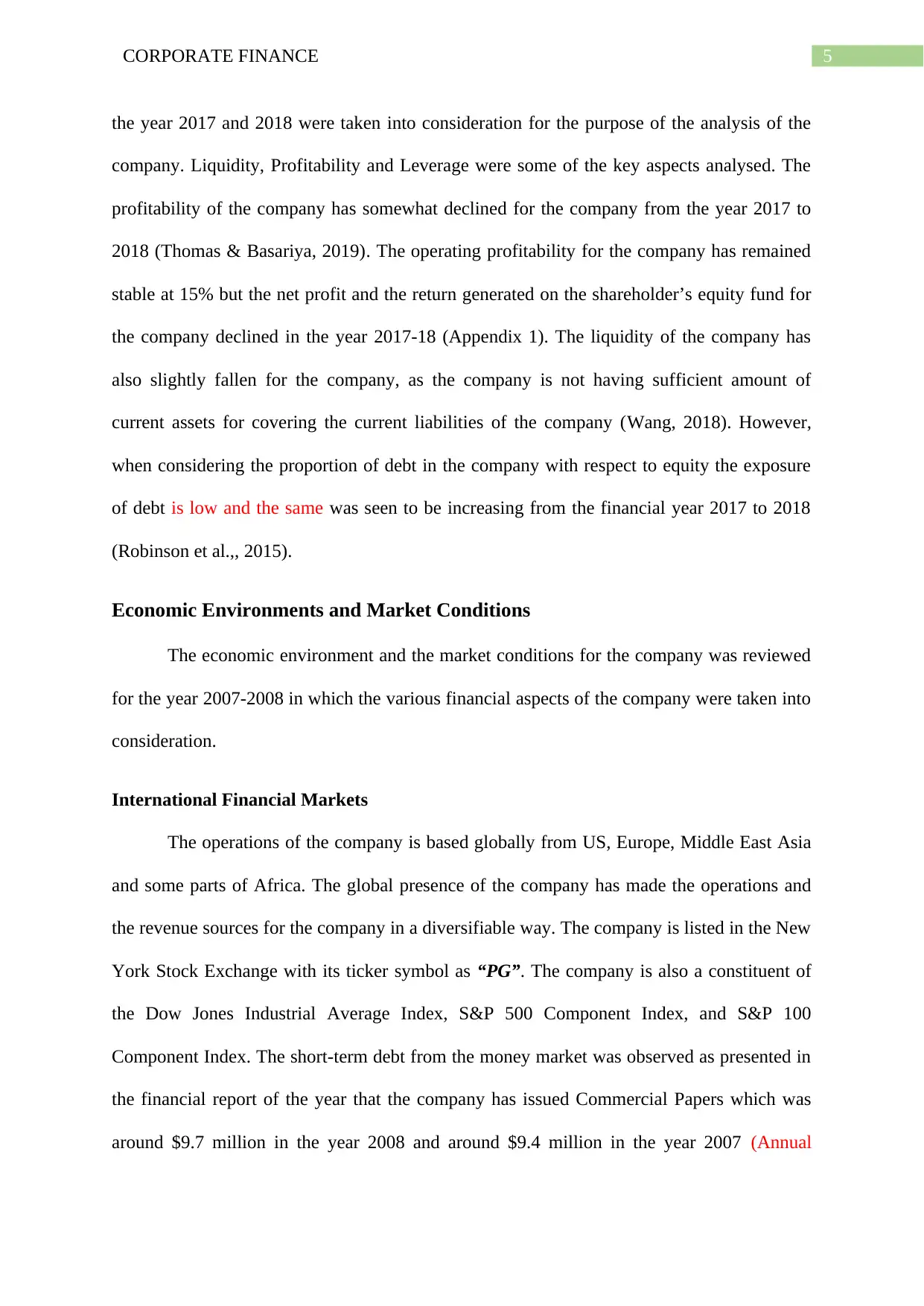
5CORPORATE FINANCE
the year 2017 and 2018 were taken into consideration for the purpose of the analysis of the
company. Liquidity, Profitability and Leverage were some of the key aspects analysed. The
profitability of the company has somewhat declined for the company from the year 2017 to
2018 (Thomas & Basariya, 2019). The operating profitability for the company has remained
stable at 15% but the net profit and the return generated on the shareholder’s equity fund for
the company declined in the year 2017-18 (Appendix 1). The liquidity of the company has
also slightly fallen for the company, as the company is not having sufficient amount of
current assets for covering the current liabilities of the company (Wang, 2018). However,
when considering the proportion of debt in the company with respect to equity the exposure
of debt is low and the same was seen to be increasing from the financial year 2017 to 2018
(Robinson et al.,, 2015).
Economic Environments and Market Conditions
The economic environment and the market conditions for the company was reviewed
for the year 2007-2008 in which the various financial aspects of the company were taken into
consideration.
International Financial Markets
The operations of the company is based globally from US, Europe, Middle East Asia
and some parts of Africa. The global presence of the company has made the operations and
the revenue sources for the company in a diversifiable way. The company is listed in the New
York Stock Exchange with its ticker symbol as “PG”. The company is also a constituent of
the Dow Jones Industrial Average Index, S&P 500 Component Index, and S&P 100
Component Index. The short-term debt from the money market was observed as presented in
the financial report of the year that the company has issued Commercial Papers which was
around $9.7 million in the year 2008 and around $9.4 million in the year 2007 (Annual
the year 2017 and 2018 were taken into consideration for the purpose of the analysis of the
company. Liquidity, Profitability and Leverage were some of the key aspects analysed. The
profitability of the company has somewhat declined for the company from the year 2017 to
2018 (Thomas & Basariya, 2019). The operating profitability for the company has remained
stable at 15% but the net profit and the return generated on the shareholder’s equity fund for
the company declined in the year 2017-18 (Appendix 1). The liquidity of the company has
also slightly fallen for the company, as the company is not having sufficient amount of
current assets for covering the current liabilities of the company (Wang, 2018). However,
when considering the proportion of debt in the company with respect to equity the exposure
of debt is low and the same was seen to be increasing from the financial year 2017 to 2018
(Robinson et al.,, 2015).
Economic Environments and Market Conditions
The economic environment and the market conditions for the company was reviewed
for the year 2007-2008 in which the various financial aspects of the company were taken into
consideration.
International Financial Markets
The operations of the company is based globally from US, Europe, Middle East Asia
and some parts of Africa. The global presence of the company has made the operations and
the revenue sources for the company in a diversifiable way. The company is listed in the New
York Stock Exchange with its ticker symbol as “PG”. The company is also a constituent of
the Dow Jones Industrial Average Index, S&P 500 Component Index, and S&P 100
Component Index. The short-term debt from the money market was observed as presented in
the financial report of the year that the company has issued Commercial Papers which was
around $9.7 million in the year 2008 and around $9.4 million in the year 2007 (Annual
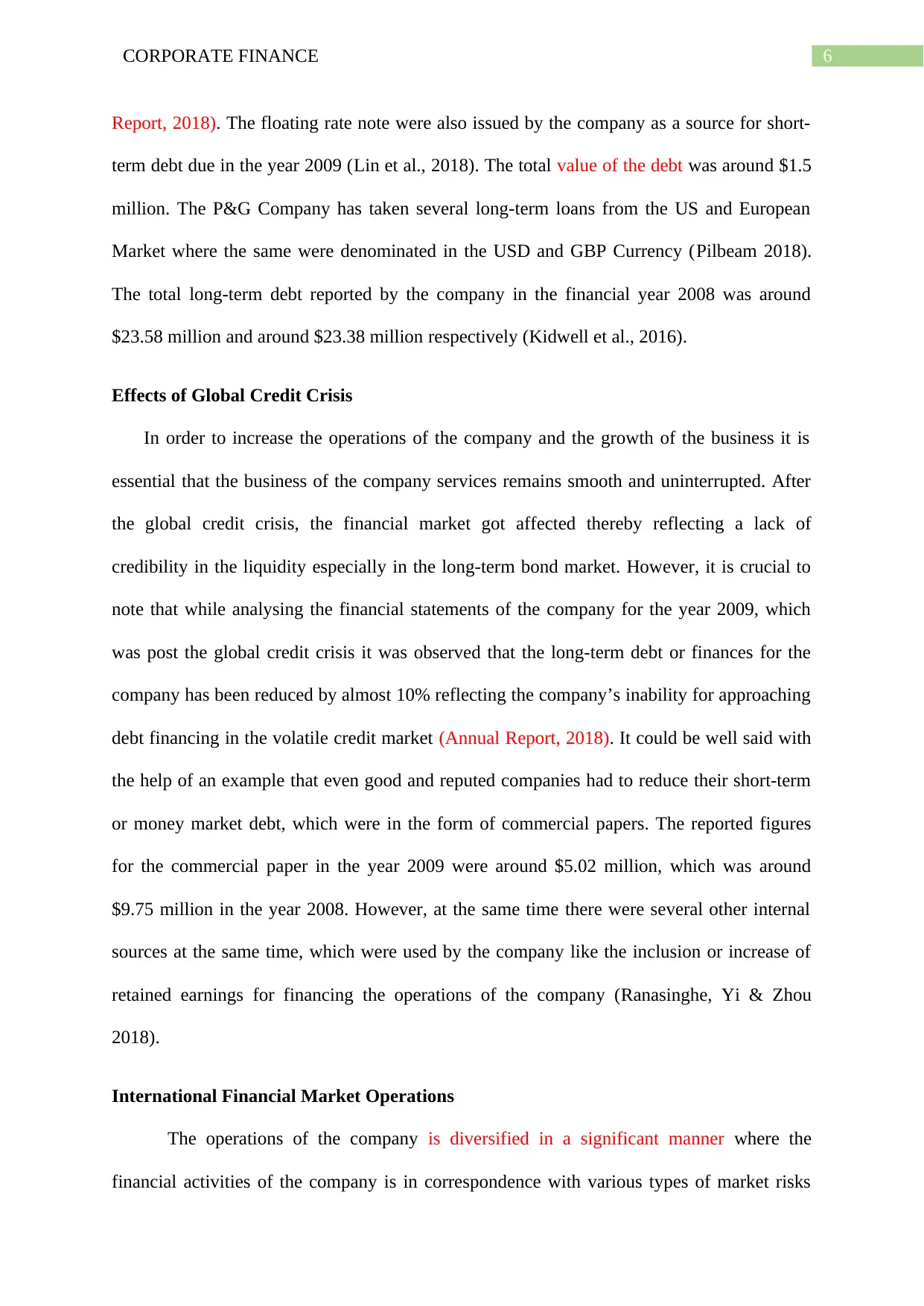
6CORPORATE FINANCE
Report, 2018). The floating rate note were also issued by the company as a source for short-
term debt due in the year 2009 (Lin et al., 2018). The total value of the debt was around $1.5
million. The P&G Company has taken several long-term loans from the US and European
Market where the same were denominated in the USD and GBP Currency (Pilbeam 2018).
The total long-term debt reported by the company in the financial year 2008 was around
$23.58 million and around $23.38 million respectively (Kidwell et al., 2016).
Effects of Global Credit Crisis
In order to increase the operations of the company and the growth of the business it is
essential that the business of the company services remains smooth and uninterrupted. After
the global credit crisis, the financial market got affected thereby reflecting a lack of
credibility in the liquidity especially in the long-term bond market. However, it is crucial to
note that while analysing the financial statements of the company for the year 2009, which
was post the global credit crisis it was observed that the long-term debt or finances for the
company has been reduced by almost 10% reflecting the company’s inability for approaching
debt financing in the volatile credit market (Annual Report, 2018). It could be well said with
the help of an example that even good and reputed companies had to reduce their short-term
or money market debt, which were in the form of commercial papers. The reported figures
for the commercial paper in the year 2009 were around $5.02 million, which was around
$9.75 million in the year 2008. However, at the same time there were several other internal
sources at the same time, which were used by the company like the inclusion or increase of
retained earnings for financing the operations of the company (Ranasinghe, Yi & Zhou
2018).
International Financial Market Operations
The operations of the company is diversified in a significant manner where the
financial activities of the company is in correspondence with various types of market risks
Report, 2018). The floating rate note were also issued by the company as a source for short-
term debt due in the year 2009 (Lin et al., 2018). The total value of the debt was around $1.5
million. The P&G Company has taken several long-term loans from the US and European
Market where the same were denominated in the USD and GBP Currency (Pilbeam 2018).
The total long-term debt reported by the company in the financial year 2008 was around
$23.58 million and around $23.38 million respectively (Kidwell et al., 2016).
Effects of Global Credit Crisis
In order to increase the operations of the company and the growth of the business it is
essential that the business of the company services remains smooth and uninterrupted. After
the global credit crisis, the financial market got affected thereby reflecting a lack of
credibility in the liquidity especially in the long-term bond market. However, it is crucial to
note that while analysing the financial statements of the company for the year 2009, which
was post the global credit crisis it was observed that the long-term debt or finances for the
company has been reduced by almost 10% reflecting the company’s inability for approaching
debt financing in the volatile credit market (Annual Report, 2018). It could be well said with
the help of an example that even good and reputed companies had to reduce their short-term
or money market debt, which were in the form of commercial papers. The reported figures
for the commercial paper in the year 2009 were around $5.02 million, which was around
$9.75 million in the year 2008. However, at the same time there were several other internal
sources at the same time, which were used by the company like the inclusion or increase of
retained earnings for financing the operations of the company (Ranasinghe, Yi & Zhou
2018).
International Financial Market Operations
The operations of the company is diversified in a significant manner where the
financial activities of the company is in correspondence with various types of market risks
⊘ This is a preview!⊘
Do you want full access?
Subscribe today to unlock all pages.

Trusted by 1+ million students worldwide
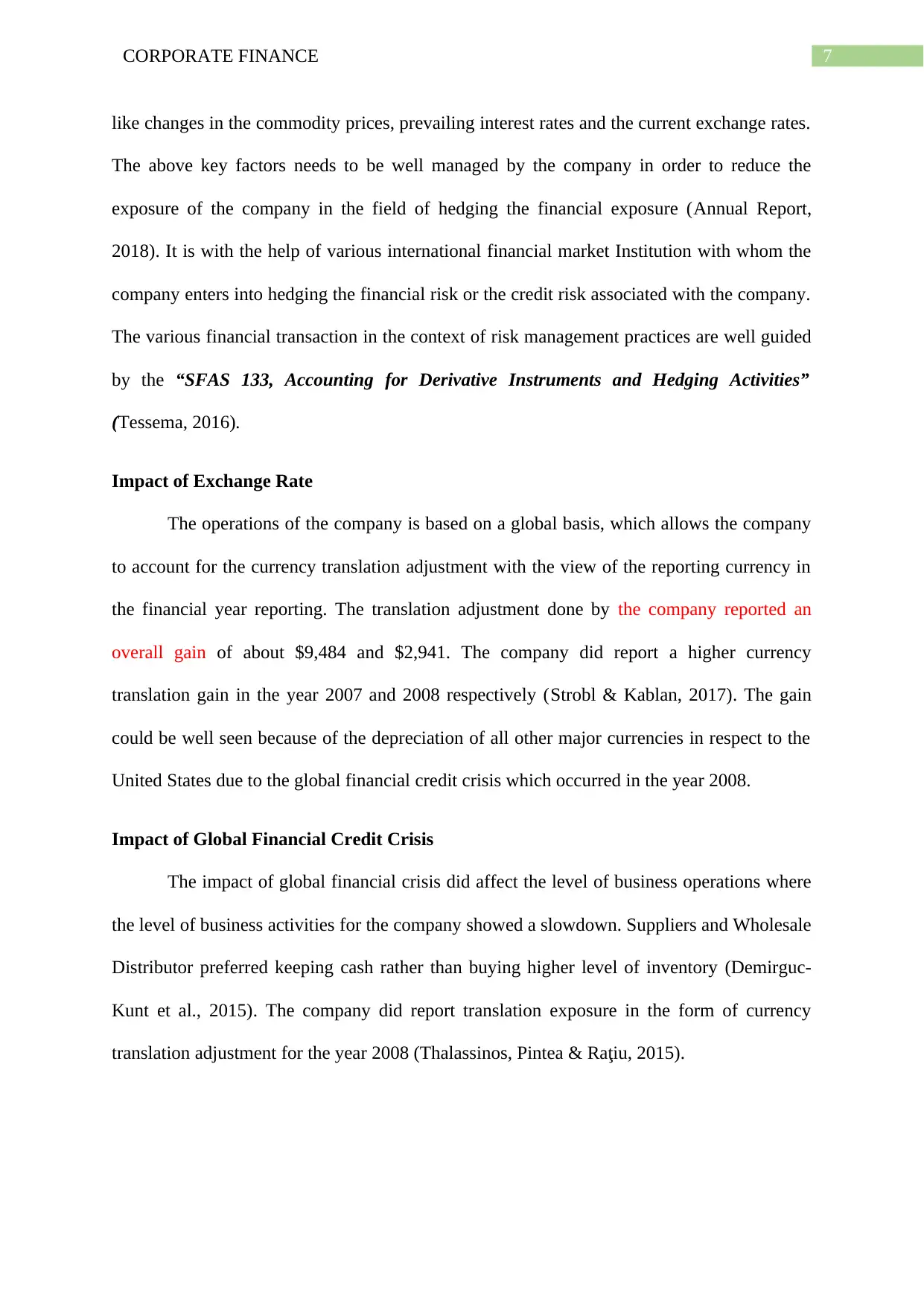
7CORPORATE FINANCE
like changes in the commodity prices, prevailing interest rates and the current exchange rates.
The above key factors needs to be well managed by the company in order to reduce the
exposure of the company in the field of hedging the financial exposure (Annual Report,
2018). It is with the help of various international financial market Institution with whom the
company enters into hedging the financial risk or the credit risk associated with the company.
The various financial transaction in the context of risk management practices are well guided
by the “SFAS 133, Accounting for Derivative Instruments and Hedging Activities”
(Tessema, 2016).
Impact of Exchange Rate
The operations of the company is based on a global basis, which allows the company
to account for the currency translation adjustment with the view of the reporting currency in
the financial year reporting. The translation adjustment done by the company reported an
overall gain of about $9,484 and $2,941. The company did report a higher currency
translation gain in the year 2007 and 2008 respectively (Strobl & Kablan, 2017). The gain
could be well seen because of the depreciation of all other major currencies in respect to the
United States due to the global financial credit crisis which occurred in the year 2008.
Impact of Global Financial Credit Crisis
The impact of global financial crisis did affect the level of business operations where
the level of business activities for the company showed a slowdown. Suppliers and Wholesale
Distributor preferred keeping cash rather than buying higher level of inventory (Demirguc-
Kunt et al., 2015). The company did report translation exposure in the form of currency
translation adjustment for the year 2008 (Thalassinos, Pintea & Raţiu, 2015).
like changes in the commodity prices, prevailing interest rates and the current exchange rates.
The above key factors needs to be well managed by the company in order to reduce the
exposure of the company in the field of hedging the financial exposure (Annual Report,
2018). It is with the help of various international financial market Institution with whom the
company enters into hedging the financial risk or the credit risk associated with the company.
The various financial transaction in the context of risk management practices are well guided
by the “SFAS 133, Accounting for Derivative Instruments and Hedging Activities”
(Tessema, 2016).
Impact of Exchange Rate
The operations of the company is based on a global basis, which allows the company
to account for the currency translation adjustment with the view of the reporting currency in
the financial year reporting. The translation adjustment done by the company reported an
overall gain of about $9,484 and $2,941. The company did report a higher currency
translation gain in the year 2007 and 2008 respectively (Strobl & Kablan, 2017). The gain
could be well seen because of the depreciation of all other major currencies in respect to the
United States due to the global financial credit crisis which occurred in the year 2008.
Impact of Global Financial Credit Crisis
The impact of global financial crisis did affect the level of business operations where
the level of business activities for the company showed a slowdown. Suppliers and Wholesale
Distributor preferred keeping cash rather than buying higher level of inventory (Demirguc-
Kunt et al., 2015). The company did report translation exposure in the form of currency
translation adjustment for the year 2008 (Thalassinos, Pintea & Raţiu, 2015).
Paraphrase This Document
Need a fresh take? Get an instant paraphrase of this document with our AI Paraphraser
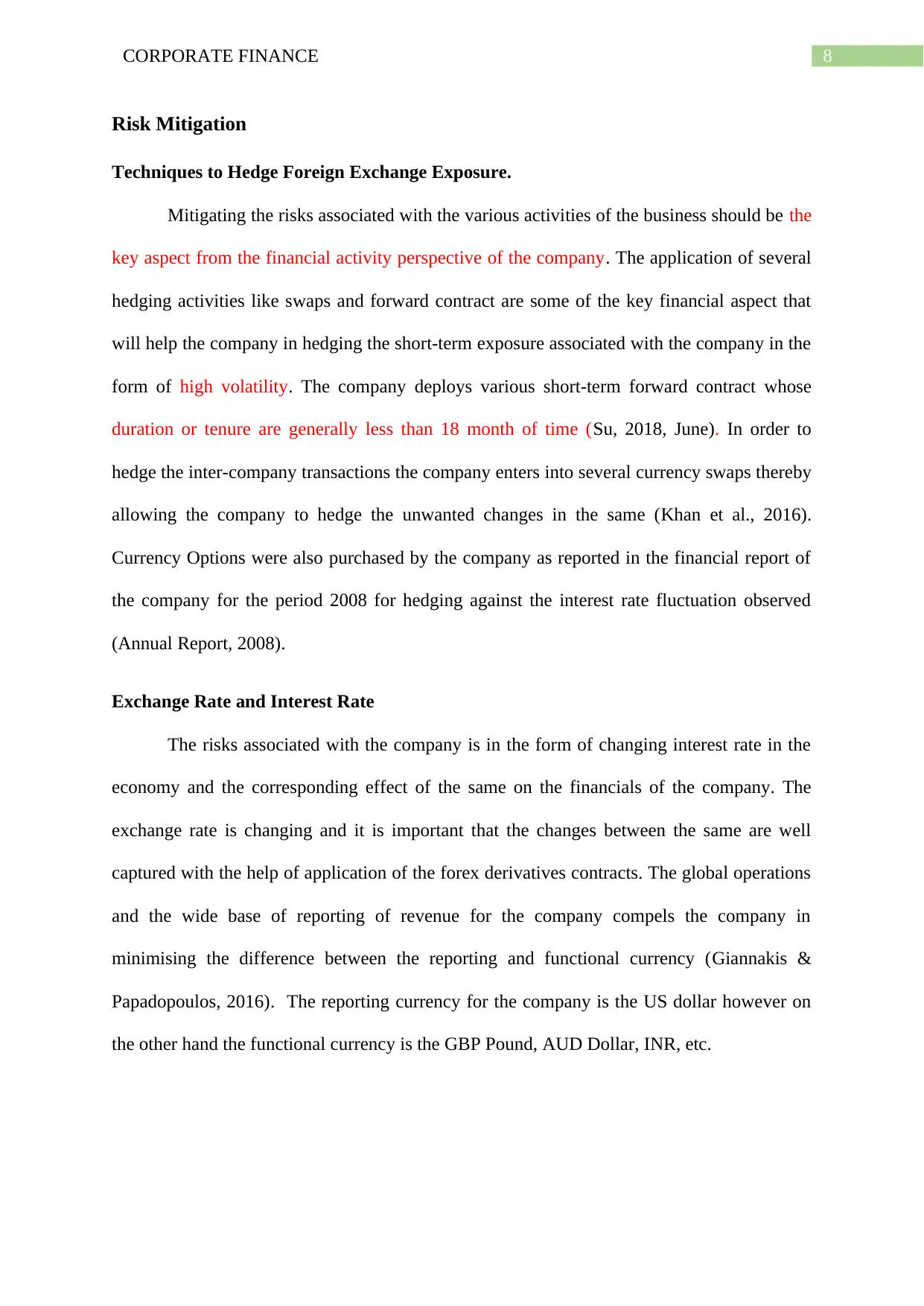
8CORPORATE FINANCE
Risk Mitigation
Techniques to Hedge Foreign Exchange Exposure.
Mitigating the risks associated with the various activities of the business should be the
key aspect from the financial activity perspective of the company. The application of several
hedging activities like swaps and forward contract are some of the key financial aspect that
will help the company in hedging the short-term exposure associated with the company in the
form of high volatility. The company deploys various short-term forward contract whose
duration or tenure are generally less than 18 month of time (Su, 2018, June). In order to
hedge the inter-company transactions the company enters into several currency swaps thereby
allowing the company to hedge the unwanted changes in the same (Khan et al., 2016).
Currency Options were also purchased by the company as reported in the financial report of
the company for the period 2008 for hedging against the interest rate fluctuation observed
(Annual Report, 2008).
Exchange Rate and Interest Rate
The risks associated with the company is in the form of changing interest rate in the
economy and the corresponding effect of the same on the financials of the company. The
exchange rate is changing and it is important that the changes between the same are well
captured with the help of application of the forex derivatives contracts. The global operations
and the wide base of reporting of revenue for the company compels the company in
minimising the difference between the reporting and functional currency (Giannakis &
Papadopoulos, 2016). The reporting currency for the company is the US dollar however on
the other hand the functional currency is the GBP Pound, AUD Dollar, INR, etc.
Risk Mitigation
Techniques to Hedge Foreign Exchange Exposure.
Mitigating the risks associated with the various activities of the business should be the
key aspect from the financial activity perspective of the company. The application of several
hedging activities like swaps and forward contract are some of the key financial aspect that
will help the company in hedging the short-term exposure associated with the company in the
form of high volatility. The company deploys various short-term forward contract whose
duration or tenure are generally less than 18 month of time (Su, 2018, June). In order to
hedge the inter-company transactions the company enters into several currency swaps thereby
allowing the company to hedge the unwanted changes in the same (Khan et al., 2016).
Currency Options were also purchased by the company as reported in the financial report of
the company for the period 2008 for hedging against the interest rate fluctuation observed
(Annual Report, 2008).
Exchange Rate and Interest Rate
The risks associated with the company is in the form of changing interest rate in the
economy and the corresponding effect of the same on the financials of the company. The
exchange rate is changing and it is important that the changes between the same are well
captured with the help of application of the forex derivatives contracts. The global operations
and the wide base of reporting of revenue for the company compels the company in
minimising the difference between the reporting and functional currency (Giannakis &
Papadopoulos, 2016). The reporting currency for the company is the US dollar however on
the other hand the functional currency is the GBP Pound, AUD Dollar, INR, etc.
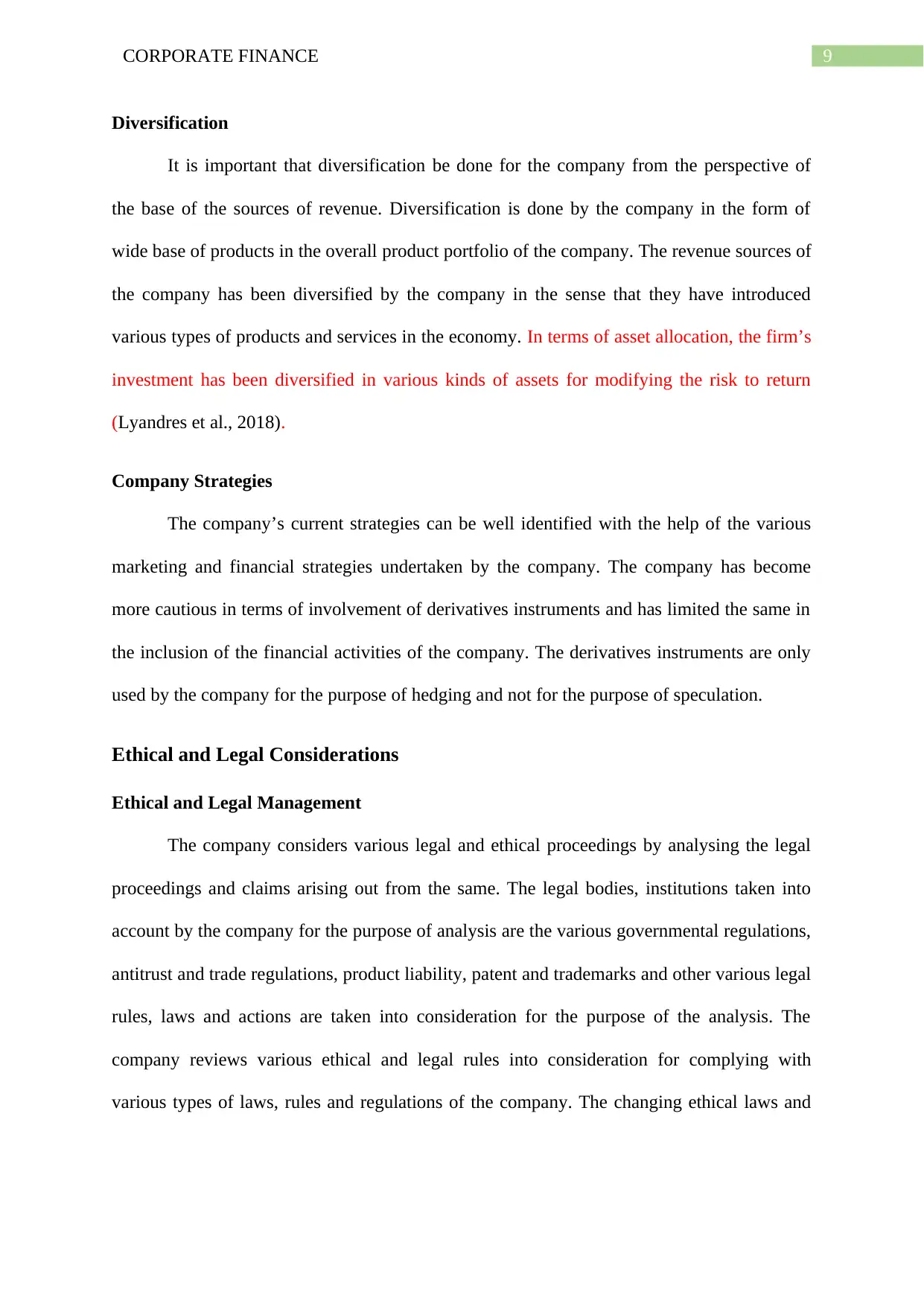
9CORPORATE FINANCE
Diversification
It is important that diversification be done for the company from the perspective of
the base of the sources of revenue. Diversification is done by the company in the form of
wide base of products in the overall product portfolio of the company. The revenue sources of
the company has been diversified by the company in the sense that they have introduced
various types of products and services in the economy. In terms of asset allocation, the firm’s
investment has been diversified in various kinds of assets for modifying the risk to return
(Lyandres et al., 2018).
Company Strategies
The company’s current strategies can be well identified with the help of the various
marketing and financial strategies undertaken by the company. The company has become
more cautious in terms of involvement of derivatives instruments and has limited the same in
the inclusion of the financial activities of the company. The derivatives instruments are only
used by the company for the purpose of hedging and not for the purpose of speculation.
Ethical and Legal Considerations
Ethical and Legal Management
The company considers various legal and ethical proceedings by analysing the legal
proceedings and claims arising out from the same. The legal bodies, institutions taken into
account by the company for the purpose of analysis are the various governmental regulations,
antitrust and trade regulations, product liability, patent and trademarks and other various legal
rules, laws and actions are taken into consideration for the purpose of the analysis. The
company reviews various ethical and legal rules into consideration for complying with
various types of laws, rules and regulations of the company. The changing ethical laws and
Diversification
It is important that diversification be done for the company from the perspective of
the base of the sources of revenue. Diversification is done by the company in the form of
wide base of products in the overall product portfolio of the company. The revenue sources of
the company has been diversified by the company in the sense that they have introduced
various types of products and services in the economy. In terms of asset allocation, the firm’s
investment has been diversified in various kinds of assets for modifying the risk to return
(Lyandres et al., 2018).
Company Strategies
The company’s current strategies can be well identified with the help of the various
marketing and financial strategies undertaken by the company. The company has become
more cautious in terms of involvement of derivatives instruments and has limited the same in
the inclusion of the financial activities of the company. The derivatives instruments are only
used by the company for the purpose of hedging and not for the purpose of speculation.
Ethical and Legal Considerations
Ethical and Legal Management
The company considers various legal and ethical proceedings by analysing the legal
proceedings and claims arising out from the same. The legal bodies, institutions taken into
account by the company for the purpose of analysis are the various governmental regulations,
antitrust and trade regulations, product liability, patent and trademarks and other various legal
rules, laws and actions are taken into consideration for the purpose of the analysis. The
company reviews various ethical and legal rules into consideration for complying with
various types of laws, rules and regulations of the company. The changing ethical laws and
⊘ This is a preview!⊘
Do you want full access?
Subscribe today to unlock all pages.

Trusted by 1+ million students worldwide
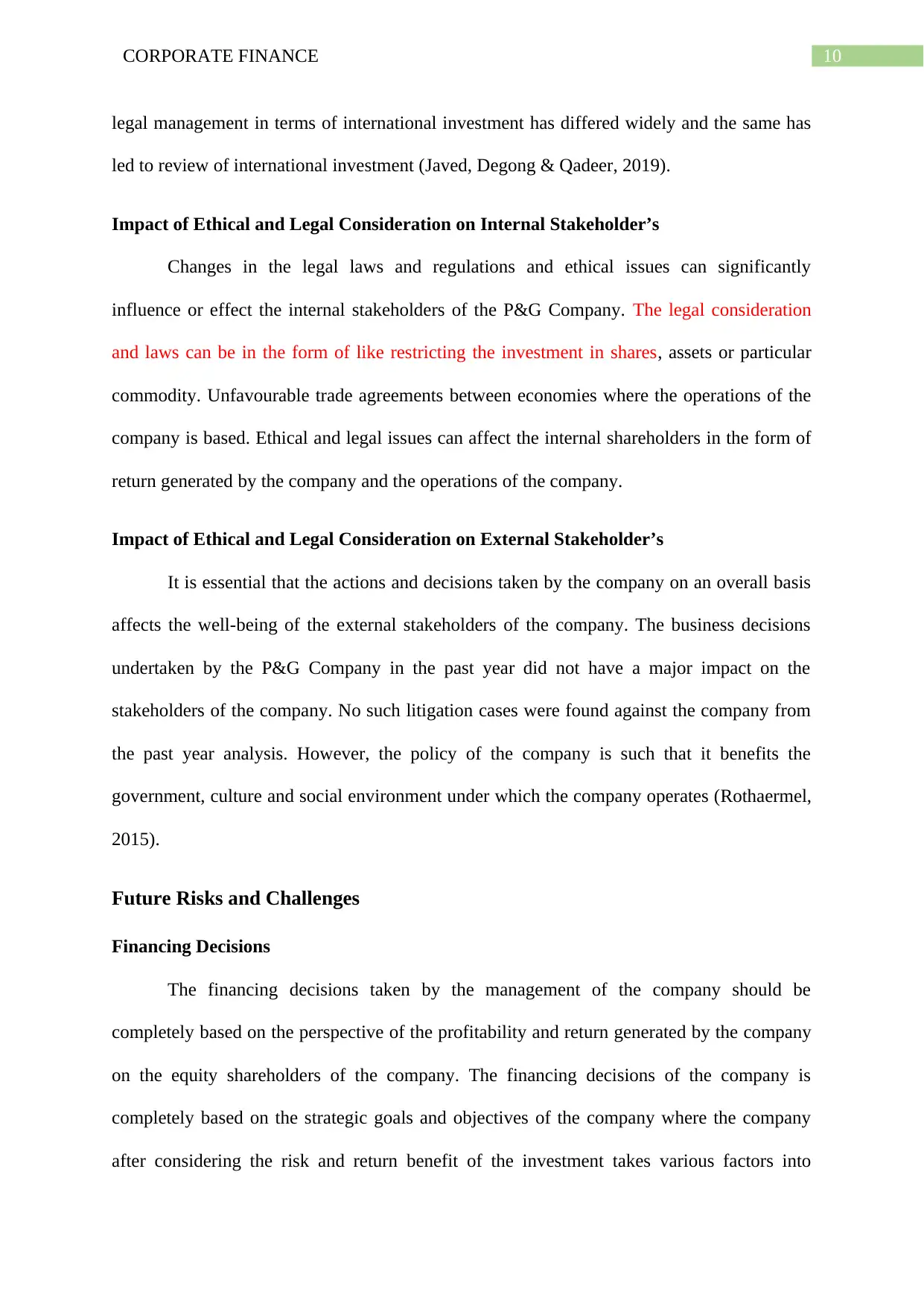
10CORPORATE FINANCE
legal management in terms of international investment has differed widely and the same has
led to review of international investment (Javed, Degong & Qadeer, 2019).
Impact of Ethical and Legal Consideration on Internal Stakeholder’s
Changes in the legal laws and regulations and ethical issues can significantly
influence or effect the internal stakeholders of the P&G Company. The legal consideration
and laws can be in the form of like restricting the investment in shares, assets or particular
commodity. Unfavourable trade agreements between economies where the operations of the
company is based. Ethical and legal issues can affect the internal shareholders in the form of
return generated by the company and the operations of the company.
Impact of Ethical and Legal Consideration on External Stakeholder’s
It is essential that the actions and decisions taken by the company on an overall basis
affects the well-being of the external stakeholders of the company. The business decisions
undertaken by the P&G Company in the past year did not have a major impact on the
stakeholders of the company. No such litigation cases were found against the company from
the past year analysis. However, the policy of the company is such that it benefits the
government, culture and social environment under which the company operates (Rothaermel,
2015).
Future Risks and Challenges
Financing Decisions
The financing decisions taken by the management of the company should be
completely based on the perspective of the profitability and return generated by the company
on the equity shareholders of the company. The financing decisions of the company is
completely based on the strategic goals and objectives of the company where the company
after considering the risk and return benefit of the investment takes various factors into
legal management in terms of international investment has differed widely and the same has
led to review of international investment (Javed, Degong & Qadeer, 2019).
Impact of Ethical and Legal Consideration on Internal Stakeholder’s
Changes in the legal laws and regulations and ethical issues can significantly
influence or effect the internal stakeholders of the P&G Company. The legal consideration
and laws can be in the form of like restricting the investment in shares, assets or particular
commodity. Unfavourable trade agreements between economies where the operations of the
company is based. Ethical and legal issues can affect the internal shareholders in the form of
return generated by the company and the operations of the company.
Impact of Ethical and Legal Consideration on External Stakeholder’s
It is essential that the actions and decisions taken by the company on an overall basis
affects the well-being of the external stakeholders of the company. The business decisions
undertaken by the P&G Company in the past year did not have a major impact on the
stakeholders of the company. No such litigation cases were found against the company from
the past year analysis. However, the policy of the company is such that it benefits the
government, culture and social environment under which the company operates (Rothaermel,
2015).
Future Risks and Challenges
Financing Decisions
The financing decisions taken by the management of the company should be
completely based on the perspective of the profitability and return generated by the company
on the equity shareholders of the company. The financing decisions of the company is
completely based on the strategic goals and objectives of the company where the company
after considering the risk and return benefit of the investment takes various factors into
Paraphrase This Document
Need a fresh take? Get an instant paraphrase of this document with our AI Paraphraser
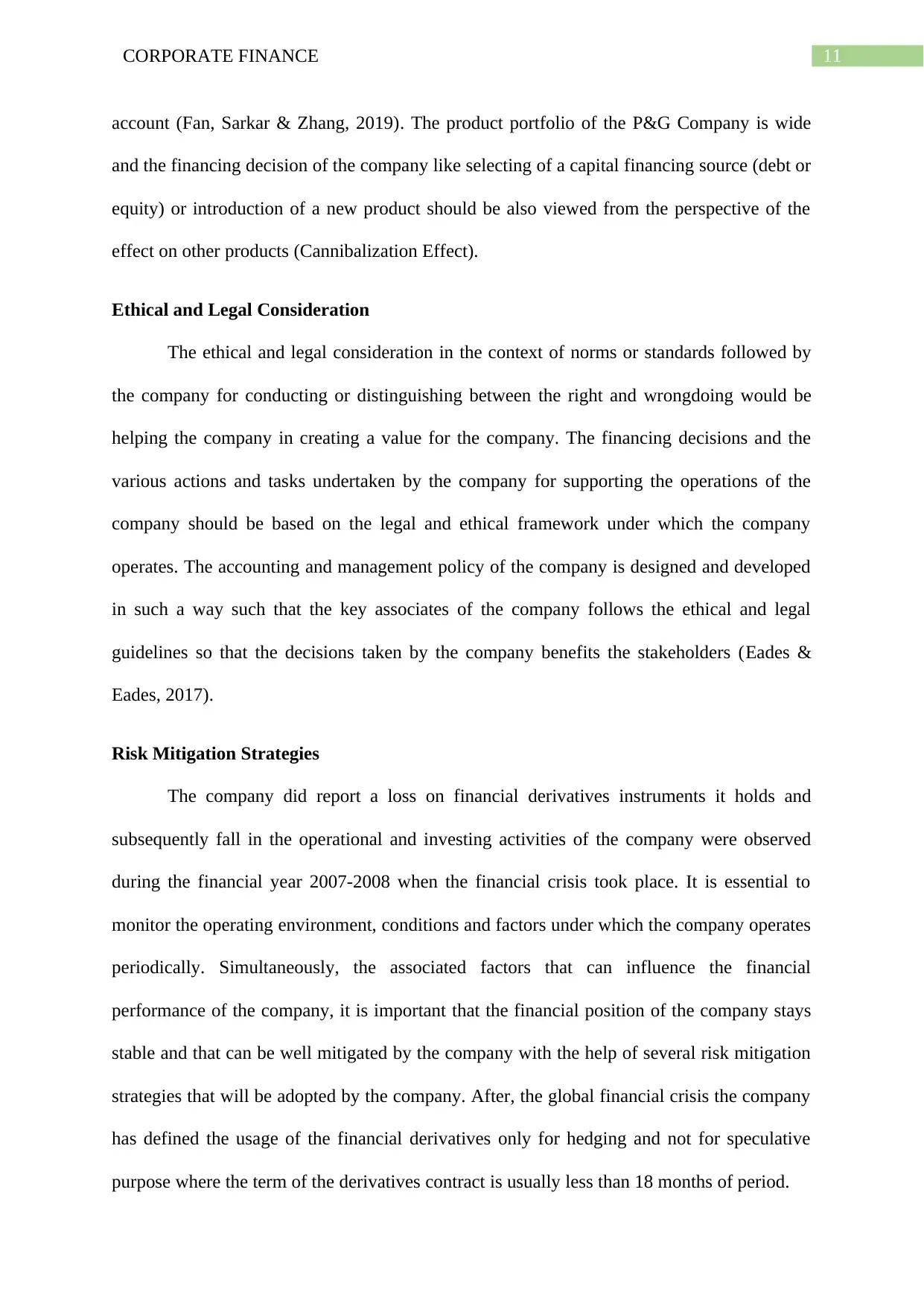
11CORPORATE FINANCE
account (Fan, Sarkar & Zhang, 2019). The product portfolio of the P&G Company is wide
and the financing decision of the company like selecting of a capital financing source (debt or
equity) or introduction of a new product should be also viewed from the perspective of the
effect on other products (Cannibalization Effect).
Ethical and Legal Consideration
The ethical and legal consideration in the context of norms or standards followed by
the company for conducting or distinguishing between the right and wrongdoing would be
helping the company in creating a value for the company. The financing decisions and the
various actions and tasks undertaken by the company for supporting the operations of the
company should be based on the legal and ethical framework under which the company
operates. The accounting and management policy of the company is designed and developed
in such a way such that the key associates of the company follows the ethical and legal
guidelines so that the decisions taken by the company benefits the stakeholders (Eades &
Eades, 2017).
Risk Mitigation Strategies
The company did report a loss on financial derivatives instruments it holds and
subsequently fall in the operational and investing activities of the company were observed
during the financial year 2007-2008 when the financial crisis took place. It is essential to
monitor the operating environment, conditions and factors under which the company operates
periodically. Simultaneously, the associated factors that can influence the financial
performance of the company, it is important that the financial position of the company stays
stable and that can be well mitigated by the company with the help of several risk mitigation
strategies that will be adopted by the company. After, the global financial crisis the company
has defined the usage of the financial derivatives only for hedging and not for speculative
purpose where the term of the derivatives contract is usually less than 18 months of period.
account (Fan, Sarkar & Zhang, 2019). The product portfolio of the P&G Company is wide
and the financing decision of the company like selecting of a capital financing source (debt or
equity) or introduction of a new product should be also viewed from the perspective of the
effect on other products (Cannibalization Effect).
Ethical and Legal Consideration
The ethical and legal consideration in the context of norms or standards followed by
the company for conducting or distinguishing between the right and wrongdoing would be
helping the company in creating a value for the company. The financing decisions and the
various actions and tasks undertaken by the company for supporting the operations of the
company should be based on the legal and ethical framework under which the company
operates. The accounting and management policy of the company is designed and developed
in such a way such that the key associates of the company follows the ethical and legal
guidelines so that the decisions taken by the company benefits the stakeholders (Eades &
Eades, 2017).
Risk Mitigation Strategies
The company did report a loss on financial derivatives instruments it holds and
subsequently fall in the operational and investing activities of the company were observed
during the financial year 2007-2008 when the financial crisis took place. It is essential to
monitor the operating environment, conditions and factors under which the company operates
periodically. Simultaneously, the associated factors that can influence the financial
performance of the company, it is important that the financial position of the company stays
stable and that can be well mitigated by the company with the help of several risk mitigation
strategies that will be adopted by the company. After, the global financial crisis the company
has defined the usage of the financial derivatives only for hedging and not for speculative
purpose where the term of the derivatives contract is usually less than 18 months of period.
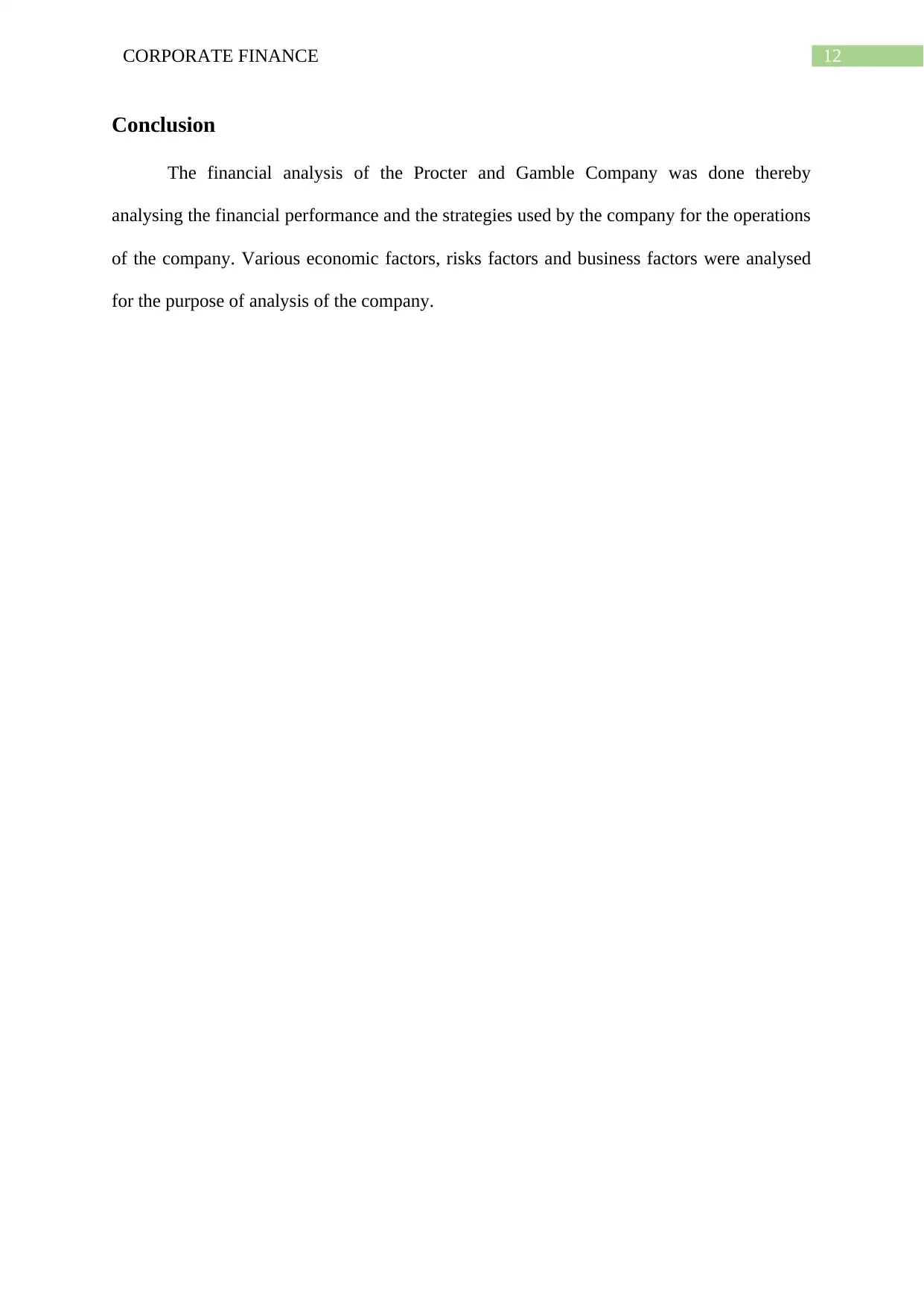
12CORPORATE FINANCE
Conclusion
The financial analysis of the Procter and Gamble Company was done thereby
analysing the financial performance and the strategies used by the company for the operations
of the company. Various economic factors, risks factors and business factors were analysed
for the purpose of analysis of the company.
Conclusion
The financial analysis of the Procter and Gamble Company was done thereby
analysing the financial performance and the strategies used by the company for the operations
of the company. Various economic factors, risks factors and business factors were analysed
for the purpose of analysis of the company.
⊘ This is a preview!⊘
Do you want full access?
Subscribe today to unlock all pages.

Trusted by 1+ million students worldwide
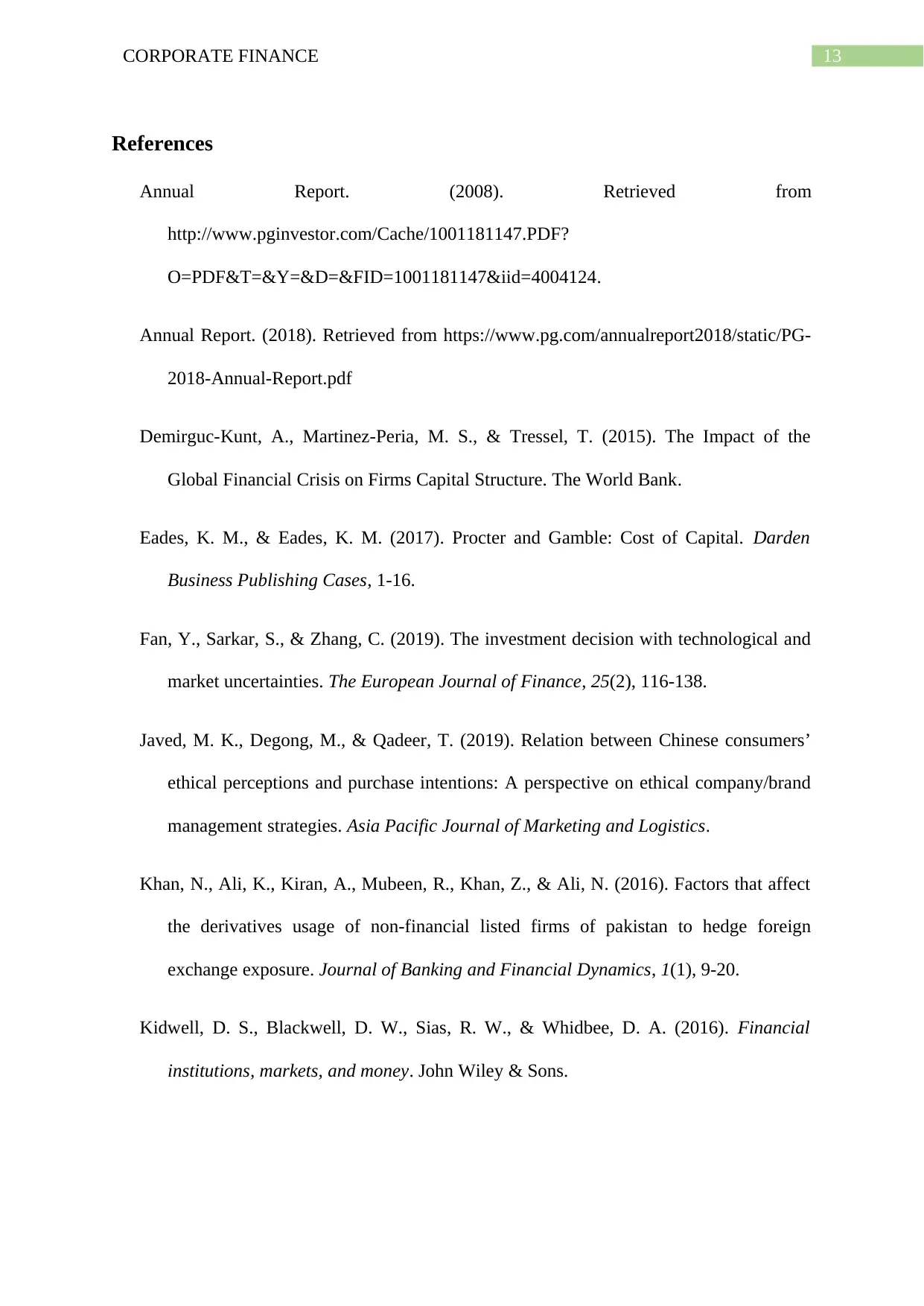
13CORPORATE FINANCE
References
Annual Report. (2008). Retrieved from
http://www.pginvestor.com/Cache/1001181147.PDF?
O=PDF&T=&Y=&D=&FID=1001181147&iid=4004124.
Annual Report. (2018). Retrieved from https://www.pg.com/annualreport2018/static/PG-
2018-Annual-Report.pdf
Demirguc-Kunt, A., Martinez-Peria, M. S., & Tressel, T. (2015). The Impact of the
Global Financial Crisis on Firms Capital Structure. The World Bank.
Eades, K. M., & Eades, K. M. (2017). Procter and Gamble: Cost of Capital. Darden
Business Publishing Cases, 1-16.
Fan, Y., Sarkar, S., & Zhang, C. (2019). The investment decision with technological and
market uncertainties. The European Journal of Finance, 25(2), 116-138.
Javed, M. K., Degong, M., & Qadeer, T. (2019). Relation between Chinese consumers’
ethical perceptions and purchase intentions: A perspective on ethical company/brand
management strategies. Asia Pacific Journal of Marketing and Logistics.
Khan, N., Ali, K., Kiran, A., Mubeen, R., Khan, Z., & Ali, N. (2016). Factors that affect
the derivatives usage of non-financial listed firms of pakistan to hedge foreign
exchange exposure. Journal of Banking and Financial Dynamics, 1(1), 9-20.
Kidwell, D. S., Blackwell, D. W., Sias, R. W., & Whidbee, D. A. (2016). Financial
institutions, markets, and money. John Wiley & Sons.
References
Annual Report. (2008). Retrieved from
http://www.pginvestor.com/Cache/1001181147.PDF?
O=PDF&T=&Y=&D=&FID=1001181147&iid=4004124.
Annual Report. (2018). Retrieved from https://www.pg.com/annualreport2018/static/PG-
2018-Annual-Report.pdf
Demirguc-Kunt, A., Martinez-Peria, M. S., & Tressel, T. (2015). The Impact of the
Global Financial Crisis on Firms Capital Structure. The World Bank.
Eades, K. M., & Eades, K. M. (2017). Procter and Gamble: Cost of Capital. Darden
Business Publishing Cases, 1-16.
Fan, Y., Sarkar, S., & Zhang, C. (2019). The investment decision with technological and
market uncertainties. The European Journal of Finance, 25(2), 116-138.
Javed, M. K., Degong, M., & Qadeer, T. (2019). Relation between Chinese consumers’
ethical perceptions and purchase intentions: A perspective on ethical company/brand
management strategies. Asia Pacific Journal of Marketing and Logistics.
Khan, N., Ali, K., Kiran, A., Mubeen, R., Khan, Z., & Ali, N. (2016). Factors that affect
the derivatives usage of non-financial listed firms of pakistan to hedge foreign
exchange exposure. Journal of Banking and Financial Dynamics, 1(1), 9-20.
Kidwell, D. S., Blackwell, D. W., Sias, R. W., & Whidbee, D. A. (2016). Financial
institutions, markets, and money. John Wiley & Sons.
Paraphrase This Document
Need a fresh take? Get an instant paraphrase of this document with our AI Paraphraser
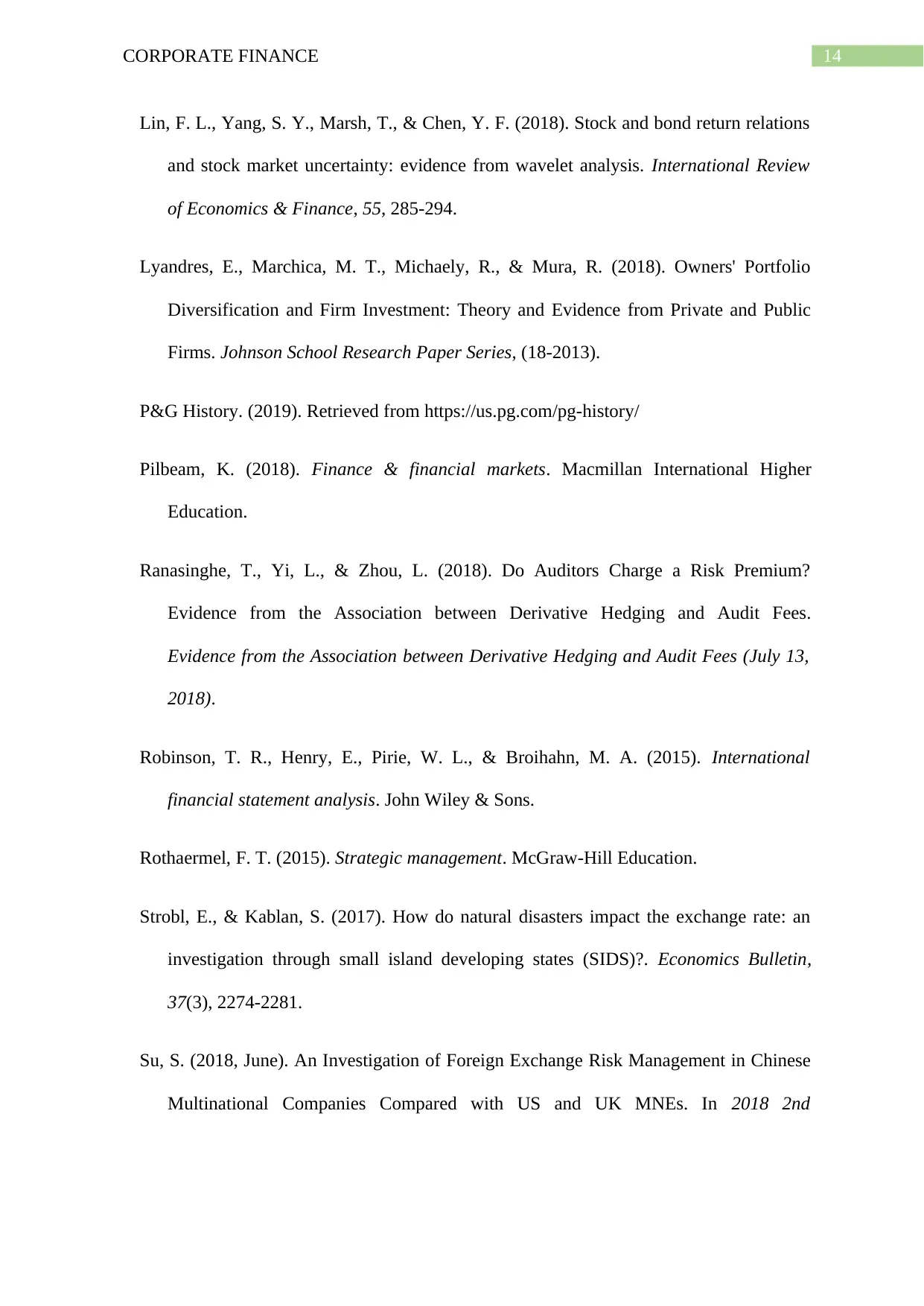
14CORPORATE FINANCE
Lin, F. L., Yang, S. Y., Marsh, T., & Chen, Y. F. (2018). Stock and bond return relations
and stock market uncertainty: evidence from wavelet analysis. International Review
of Economics & Finance, 55, 285-294.
Lyandres, E., Marchica, M. T., Michaely, R., & Mura, R. (2018). Owners' Portfolio
Diversification and Firm Investment: Theory and Evidence from Private and Public
Firms. Johnson School Research Paper Series, (18-2013).
P&G History. (2019). Retrieved from https://us.pg.com/pg-history/
Pilbeam, K. (2018). Finance & financial markets. Macmillan International Higher
Education.
Ranasinghe, T., Yi, L., & Zhou, L. (2018). Do Auditors Charge a Risk Premium?
Evidence from the Association between Derivative Hedging and Audit Fees.
Evidence from the Association between Derivative Hedging and Audit Fees (July 13,
2018).
Robinson, T. R., Henry, E., Pirie, W. L., & Broihahn, M. A. (2015). International
financial statement analysis. John Wiley & Sons.
Rothaermel, F. T. (2015). Strategic management. McGraw-Hill Education.
Strobl, E., & Kablan, S. (2017). How do natural disasters impact the exchange rate: an
investigation through small island developing states (SIDS)?. Economics Bulletin,
37(3), 2274-2281.
Su, S. (2018, June). An Investigation of Foreign Exchange Risk Management in Chinese
Multinational Companies Compared with US and UK MNEs. In 2018 2nd
Lin, F. L., Yang, S. Y., Marsh, T., & Chen, Y. F. (2018). Stock and bond return relations
and stock market uncertainty: evidence from wavelet analysis. International Review
of Economics & Finance, 55, 285-294.
Lyandres, E., Marchica, M. T., Michaely, R., & Mura, R. (2018). Owners' Portfolio
Diversification and Firm Investment: Theory and Evidence from Private and Public
Firms. Johnson School Research Paper Series, (18-2013).
P&G History. (2019). Retrieved from https://us.pg.com/pg-history/
Pilbeam, K. (2018). Finance & financial markets. Macmillan International Higher
Education.
Ranasinghe, T., Yi, L., & Zhou, L. (2018). Do Auditors Charge a Risk Premium?
Evidence from the Association between Derivative Hedging and Audit Fees.
Evidence from the Association between Derivative Hedging and Audit Fees (July 13,
2018).
Robinson, T. R., Henry, E., Pirie, W. L., & Broihahn, M. A. (2015). International
financial statement analysis. John Wiley & Sons.
Rothaermel, F. T. (2015). Strategic management. McGraw-Hill Education.
Strobl, E., & Kablan, S. (2017). How do natural disasters impact the exchange rate: an
investigation through small island developing states (SIDS)?. Economics Bulletin,
37(3), 2274-2281.
Su, S. (2018, June). An Investigation of Foreign Exchange Risk Management in Chinese
Multinational Companies Compared with US and UK MNEs. In 2018 2nd
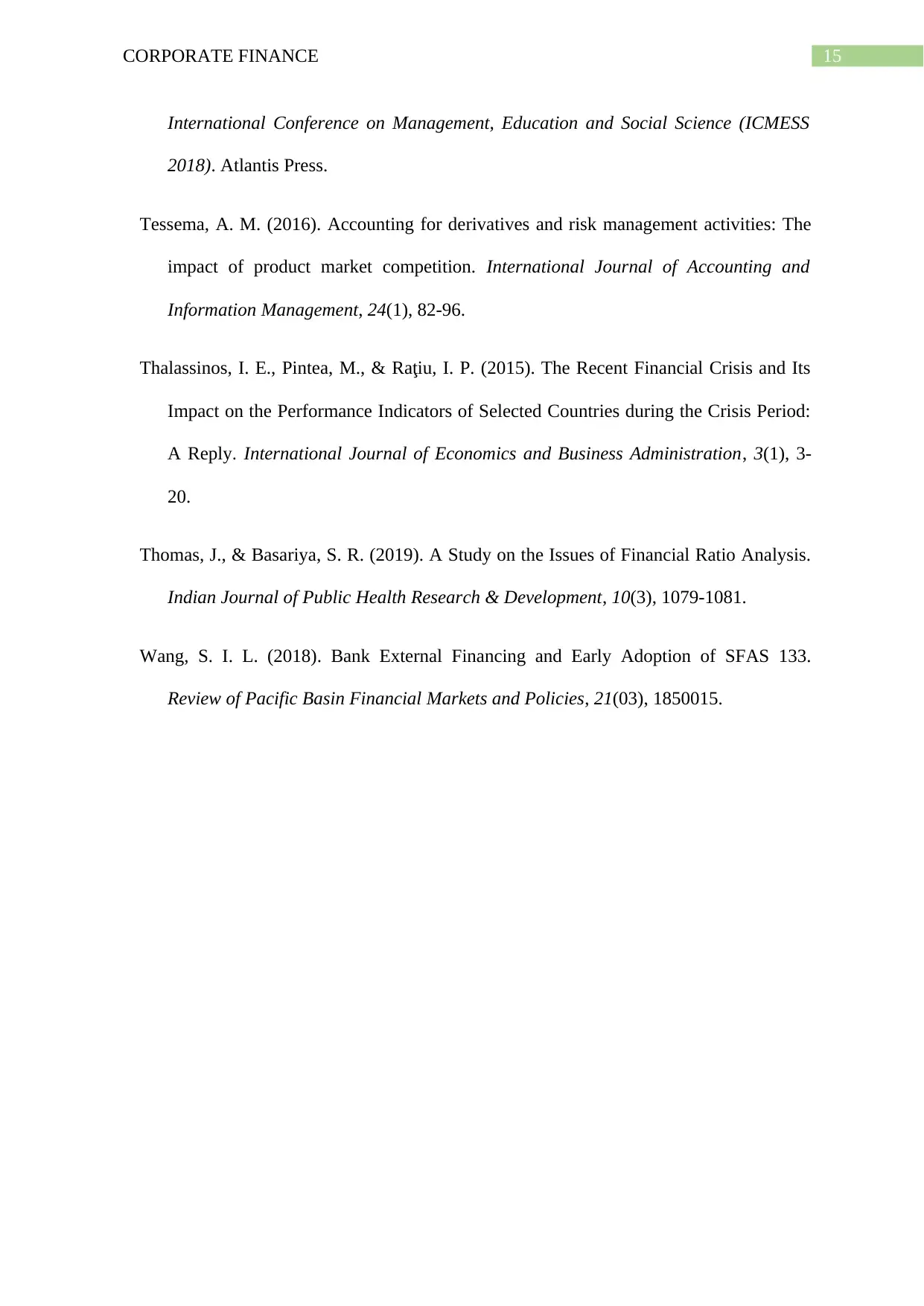
15CORPORATE FINANCE
International Conference on Management, Education and Social Science (ICMESS
2018). Atlantis Press.
Tessema, A. M. (2016). Accounting for derivatives and risk management activities: The
impact of product market competition. International Journal of Accounting and
Information Management, 24(1), 82-96.
Thalassinos, I. E., Pintea, M., & Raţiu, I. P. (2015). The Recent Financial Crisis and Its
Impact on the Performance Indicators of Selected Countries during the Crisis Period:
A Reply. International Journal of Economics and Business Administration, 3(1), 3-
20.
Thomas, J., & Basariya, S. R. (2019). A Study on the Issues of Financial Ratio Analysis.
Indian Journal of Public Health Research & Development, 10(3), 1079-1081.
Wang, S. I. L. (2018). Bank External Financing and Early Adoption of SFAS 133.
Review of Pacific Basin Financial Markets and Policies, 21(03), 1850015.
International Conference on Management, Education and Social Science (ICMESS
2018). Atlantis Press.
Tessema, A. M. (2016). Accounting for derivatives and risk management activities: The
impact of product market competition. International Journal of Accounting and
Information Management, 24(1), 82-96.
Thalassinos, I. E., Pintea, M., & Raţiu, I. P. (2015). The Recent Financial Crisis and Its
Impact on the Performance Indicators of Selected Countries during the Crisis Period:
A Reply. International Journal of Economics and Business Administration, 3(1), 3-
20.
Thomas, J., & Basariya, S. R. (2019). A Study on the Issues of Financial Ratio Analysis.
Indian Journal of Public Health Research & Development, 10(3), 1079-1081.
Wang, S. I. L. (2018). Bank External Financing and Early Adoption of SFAS 133.
Review of Pacific Basin Financial Markets and Policies, 21(03), 1850015.
⊘ This is a preview!⊘
Do you want full access?
Subscribe today to unlock all pages.

Trusted by 1+ million students worldwide
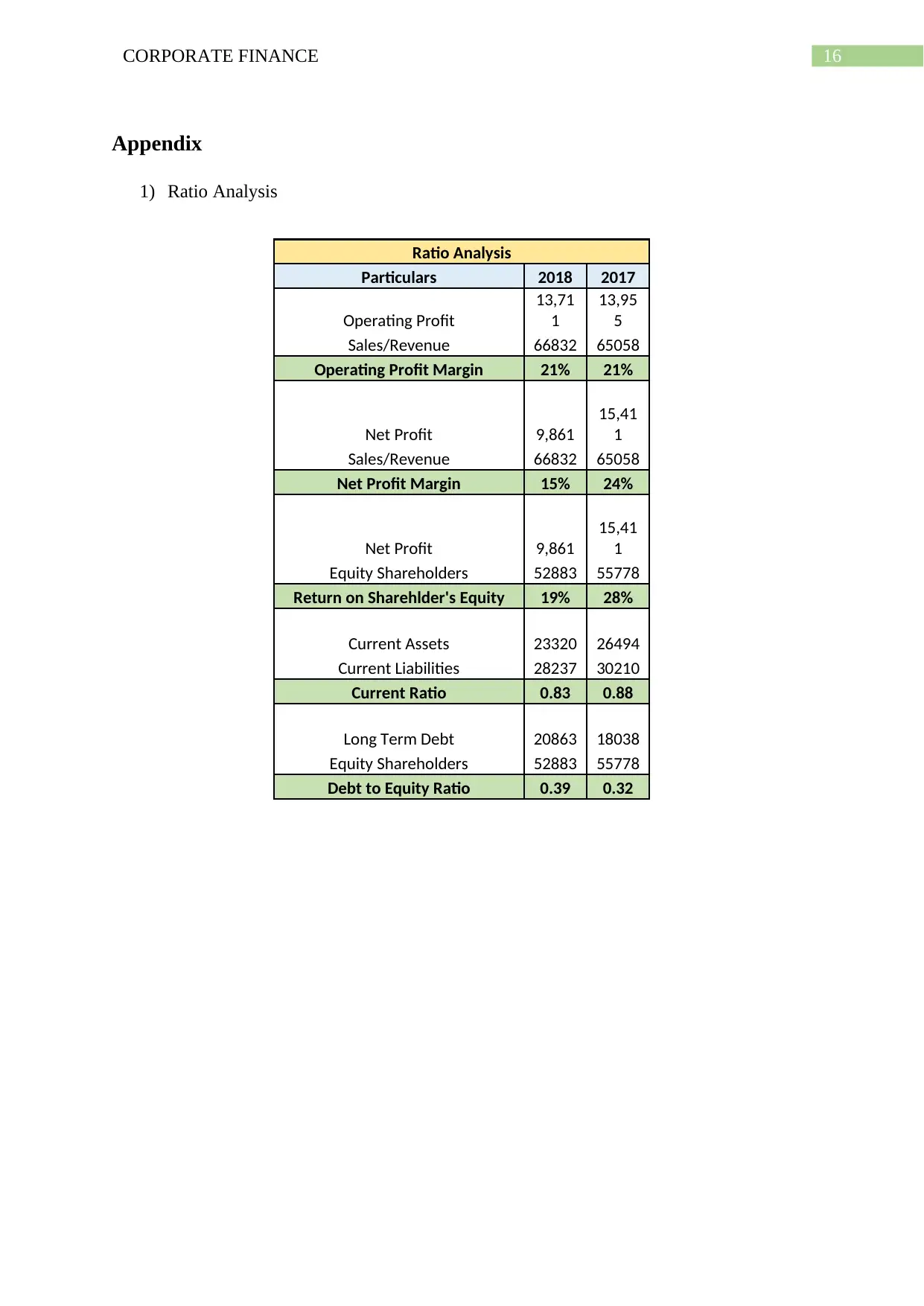
16CORPORATE FINANCE
Appendix
1) Ratio Analysis
Ratio Analysis
Particulars 2018 2017
Operating Profit
13,71
1
13,95
5
Sales/Revenue 66832 65058
Operating Profit Margin 21% 21%
Net Profit 9,861
15,41
1
Sales/Revenue 66832 65058
Net Profit Margin 15% 24%
Net Profit 9,861
15,41
1
Equity Shareholders 52883 55778
Return on Sharehlder's Equity 19% 28%
Current Assets 23320 26494
Current Liabilities 28237 30210
Current Ratio 0.83 0.88
Long Term Debt 20863 18038
Equity Shareholders 52883 55778
Debt to Equity Ratio 0.39 0.32
Appendix
1) Ratio Analysis
Ratio Analysis
Particulars 2018 2017
Operating Profit
13,71
1
13,95
5
Sales/Revenue 66832 65058
Operating Profit Margin 21% 21%
Net Profit 9,861
15,41
1
Sales/Revenue 66832 65058
Net Profit Margin 15% 24%
Net Profit 9,861
15,41
1
Equity Shareholders 52883 55778
Return on Sharehlder's Equity 19% 28%
Current Assets 23320 26494
Current Liabilities 28237 30210
Current Ratio 0.83 0.88
Long Term Debt 20863 18038
Equity Shareholders 52883 55778
Debt to Equity Ratio 0.39 0.32
1 out of 16
Related Documents
Your All-in-One AI-Powered Toolkit for Academic Success.
+13062052269
info@desklib.com
Available 24*7 on WhatsApp / Email
![[object Object]](/_next/static/media/star-bottom.7253800d.svg)
Unlock your academic potential
© 2024 | Zucol Services PVT LTD | All rights reserved.





